Father-son duo update world’s most important physiology book
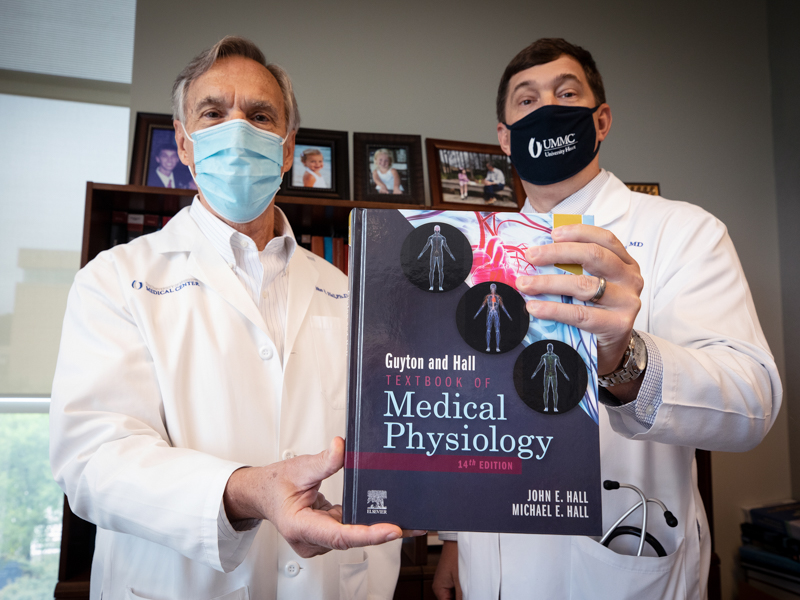
The book that has attracted rave reviews for decades, drummed up crowds of autograph seekers, been translated into about two dozen languages, and remained in demand in this country and several others around the world since its first printing in 1956, is now in its 14th edition.
It’s about bodily functions.
More precisely, the Guyton and Hall Textbook of Medical Physiology, published by Elsevier this summer, breaks down the physical and chemical processes associated with living in the human body.
Over the years, the authors have updated and enhanced the tome of 1,000-plus pages, but perhaps the most visible change in this latest edition is expressed by the names of the editors/writers printed on the front cover: Dr. John E. Hall and, for the first time ever, Dr. Michael E. Hall.
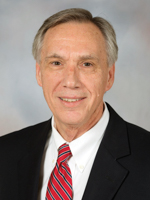
“I was glad to get some help,” said John Hall, Arthur C. Guyton Professor and Chair, Department of Physiology and Biophysics at the University of Mississippi Medical Center. “It’s a lot of work.”
That help came from his son; Dr. Michael Hall is associate professor of cardiology, and associate vice chair for research in the UMMC Department of Medicine.
“I have been doing this for a while, and I asked him if he would be interested in this,” said John Hall, whose many honors include the Southeastern Conference’s 2014 Professor of the Year.
“I thought it would be a good opportunity for him, as well as an opportunity to add some of his clinical insights to the text. He contributed to the chapters on the heart, which is really his area of expertise.”
In the beginning, and for years, the sole expert, author and editor of the textbook was Dr. Arthur C. Guyton, whose name graces the endowed chair now held by John Hall, Guyton’s former postdoctoral fellow, then colleague, for nearly three decades.
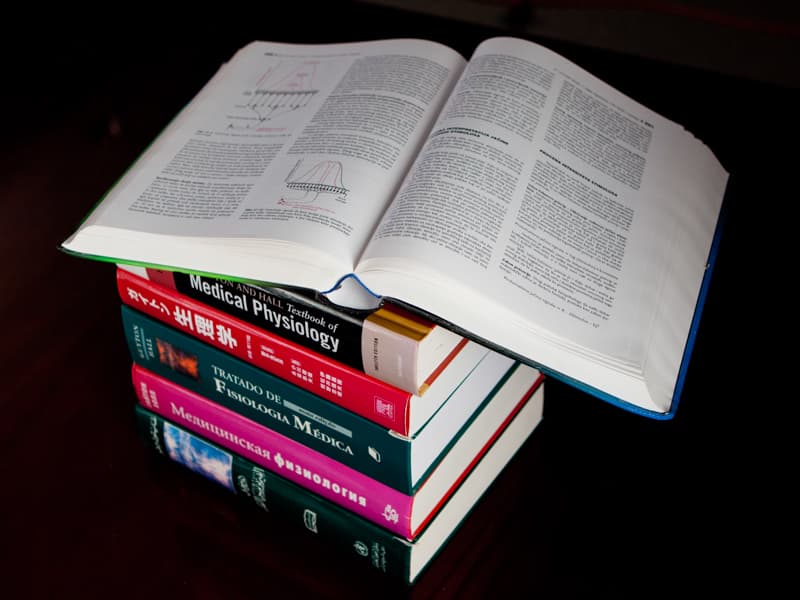
“He was a tremendous role model,” John Hall said. “No one has had a greater impact on my career.”
Guyton’s name has also graced the Medical Center in general, and still does. He is a legendary figure whose research helped revolutionize the treatment of hypertension, heart failure and other cardiovascular diseases.
He was known for his courage in coping with paralysis from polio contracted as an adult, overcoming skepticism about his health and stamina to become the chair of the Department of Physiology at the University of Mississippi in Oxford before Guyton and the department relocated to Jackson in 1955 to the newly-opened Medical Center.
The following year, his physiology textbook was published for the first time; it remains the best-selling volume on the subject in the world.
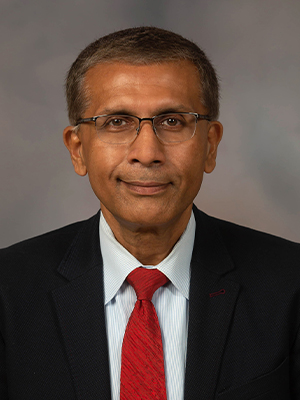
“It’s impossible to overstate the importance of this book,” said Dr. Javed Butler, professor and chair of the Department of Medicine, Patrick H. Lehan Chair of Cardiovascular Medicine at UMMC.
“This is the book that medical schools around the world use to teach students how to become doctors.
“Anatomy and physiology together are the basics that inform the practice of medicine. And this is the most important book in the whole world on physiology,” said Butler, whose own medical student training included the Guyton and Hall textbook.
“There is nothing you do in medicine where you don’t use the principles described in it.”
A big reason for the volume’s soaring status is stated in the preface to the current edition: “[Guyton] wrote the book to help students learn physiology, not to impress his professional colleagues.”
“Dr. Guyton pointed out early on that a lot of the available physiology books had a lot of detail and a lot of material that was really above the heads of medical students in general,” John Hall said.
“This book has been used not only by medical students, but also by nursing students, dental students, veterinary medical students as well as graduate students and Ph.D. candidates and other health care professionals.
“It has to be written in a way that’s easily understood, so that a wide variety of students can use it effectively. We have tried to keep to that principle, and make it even more useful for students.”
One of its salient features sets it far apart from most medical textbooks, Butler said. “When these books are written on whatever specialty, the editors may invite a hundred subspecialists to write specific chapters.
“That’s not what this book is; this book, which is about the entire human body, is now written by Dr. John Hall and Dr. Michael Hall. They don’t ask others to write the chapters. So there is the consistency in language and the almost unbelievable mastery of the topic, and they keep doing it year after year.
“It started with Dr. Guyton, and Dr. [John] Hall assumed the mantle.”
Guyton wrote and edited the first eight editions. John Hall joined him afterward, authoring parts of the ninth and 10th editions. After Guyton’s death, in a traffic accident that also took the life of his wife Ruth Weigle Guyton in April 2003, John Hall has been revising the book since around 2006, alone. Until now.
As Guyton’s successors, John Hall and Michael Hall have produced an atlas of the human body in 80-plus chapters.
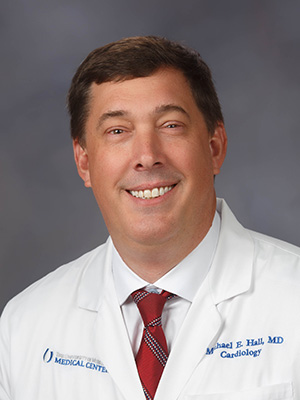
“I played a small role,” Michael Hall said. “This is something Dr. Guyton built from scratch. My dad had been doing it by himself for many years, but I hope to be more involved in the future.
“I believe the writing style is the reason it’s been popular with students. I believe they enjoy reading it compared to other textbooks. The format is comprehensive, but easy for a busy medical student to understand. I actually used the book myself in undergraduate and medical school.”
While the textbook is well-regarded in the United States, it is practically a cultural icon in some countries, particularly in Latin American nations, as well as in India.
“Last year Michael and I were in Brazil,” John Hall said. “There were two medical schools in the city we were in, and students had lined up to get autographs and photographs. They really appreciate the book.”
The more recent editions, including this one, offer features to nourish that level of appreciation. For instance, the work is accompanied by two ancillary books. One is a pocket companion, “a condensed version we hope the students carry around with them,” John Hall said.
The other is a review of the subject matter, with about 1,000 questions drawn from the text; the answers appear at the end of each unit.
Instructors who adopt the book have access to a Power Point presentation for each of the chapters, from “Functional Organization of the Human Body and Control of the ‘Internal Environment’” to “Sports Physiology.”
“Things are changing, and we’re trying to evolve,” John Hall said.
This evolution includes, depending on the nature of the material, text in one of two different font sizes; one size, for instance, may be a signpost to new developments in the field or information that may be useful for students who wish to study physiology more deeply.
And, for the last three or so versions, an e-edition, has been available with hyperlinks that make it easier to navigate the book, including links to additional content, along with video animations and self-assessment questions the student can call up on a computer, smart phone or electronic tablet.
“You can click on a hyperlink that will take you to the sound of a beating heart,” John Hall said. “You may even see the EKG. The animations illustrate, for instance, nervous reflexes, lung mechanics or other body functions.
“We want to do more of that, and will in the future.”
The last, previous edition of the textbook came out in 2015, Michael Hall said. “But editing it is ongoing. I’ve learned from my dad that as soon as one edition is written, you’re accumulating material for the next one.
“But the focus is not always on adding information.”
As John Hall said, they don’t want to book to get any bigger. “If we add something, we have to take something out, something that is now less important to include or no longer relevant.
“Otherwise, it can get too large, and it can’t be used in classes. Even 1,000 pages for an entire course is a lot for students.”
Students in a multitude of foreign countries have also explored this trove of physiological insights for years now; since 1996 it has been available in about 22 languages, counting English. There is also an international English version which is sold in such countries as India, John Hall said.
“The content is essentially the same, but printed on cheaper paper to make it more affordable.”
It is quite possible that the Guyton-Hall work is available in several more languages; apparently, some translations have emerged, minus official permission.
“The book has been translated into some languages I didn’t even know existed,” John Hall said.
Whatever the language, whether it’s Spanish or Hindi, the interpretation always comes down to the same thing: Un triunfo. Saphalata. A triumph. A success.
“It’s a once-in-a-lifetime book,” Butler said. “There are only two medical textbooks that I know of that have become the standard globally: Gray’s Anatomy and this one.
“I would say the University of Mississippi Medical Center should be incredibly proud that we are the home of this textbook.”


